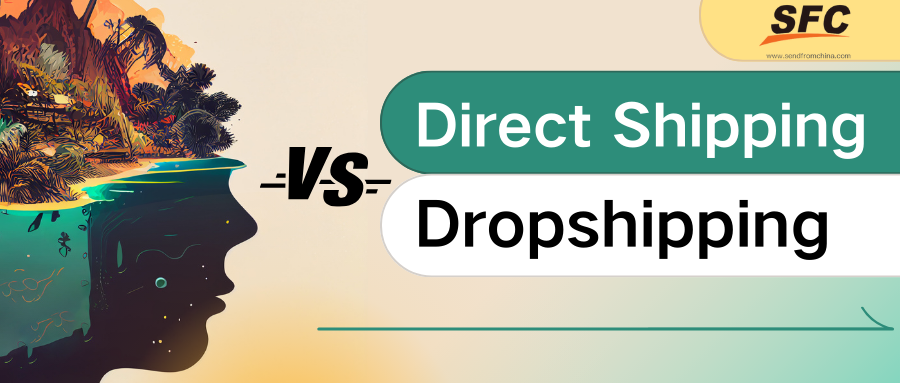Table of Contents
Direct Shipping vs Dropshipping: Which One Is the Best Fulfillment Method
Time: Nov 18,2024 Author: SFC Source: www.sendfromchina.com
Choosing the right order fulfillment method is a critical decision for any eCommerce business. Whether you’re launching a new venture or scaling an established store, understanding the differences between direct shipping and dropshipping can significantly impact your success. Each model comes with unique advantages, challenges, and opportunities, making it essential to align your choice with your business goals.In this guide, we’ll break down the pros and cons of both methods, helping you decide which is the best fit for your business strategy and long-term growth.

1. What Is Direct Shipping
Direct shipping is a fulfillment method where businesses purchase products in bulk from suppliers, store them, and ship them directly to customers. It often involves the use of warehouses or third-party logistics providers to manage inventory and fulfill orders.By managing stock and fulfillment in-house or through trusted partners, direct shipping gives businesses complete control over product quality, branding, and delivery speed. Direct shipping is particularly suitable for businesses with established customer bases or those aiming to build a unique brand experience.
2. What Is Dropshipping

While dropshipping reduces the burden of inventory management and logistics, it also limits control over product quality and delivery speed, potentially impacting customer satisfaction.
3. Advantages and Disadvantages of Direct Shipping
Direct shipping, often referred to as "direct delivery," involves shipping goods directly from the supplier or manufacturer to the customer without passing through intermediaries such as distribution centers or warehouses. Here are the advantages and disadvantages of direct shipping:Advantages of Direct Shipping
1. Reduced Lead TimesBy eliminating intermediaries, direct shipping reduces the time it takes for products to reach the customer, improving delivery speed.
2. Lower Handling Costs

3. Simplified Supply Chain
A direct shipping model simplifies the logistics process, requiring fewer stages and parties to coordinate.
4. Increased Customer Satisfaction
Faster deliveries and fewer handling errors often lead to higher customer satisfaction levels.
5. Reduced Inventory Costs
Suppliers or manufacturers can ship on-demand, reducing the need for holding inventory at multiple points.
6. Minimized Risk of Damage
Fewer handling steps lower the chances of goods being damaged in transit.
7. Scalability
Direct shipping is particularly advantageous for businesses with large-scale operations or drop-shipping models, allowing them to cater to global markets more easily.
Disadvantages of Direct Shipping
1. Higher Shipping CostsShipping individual orders directly to customers can be more expensive than consolidating shipments to a central location.
2. Limited Control Over Delivery
Businesses may have less control over the shipping process since third-party carriers are often responsible for final delivery.
3. Complexity in Returns
Managing returns and reverse logistics can be challenging when goods are shipped directly from the supplier to the customer.
4. Inconsistent Branding
Suppliers or manufacturers may not follow the company's packaging or branding standards, leading to an inconsistent customer experience.
5. Dependence on Supplier
Businesses relying on direct shipping are dependent on their suppliers’ shipping capabilities and timelines.
6. Customs and Compliance Challenges
For international shipments, direct shipping may complicate customs clearance and regulatory compliance due to the lack of centralized processing.
7. Reduced Bulk Discounts
Direct shipping typically involves smaller shipment sizes, which may eliminate the cost advantages of bulk shipping discounts.
4. Advantages and Disadvantages of Dropshipping

Advantages of Dropshipping
1. Low Startup CostsAdvantage: Dropshipping eliminates the need for upfront investment in inventory, warehousing, or logistics. This significantly reduces initial capital requirements, making it accessible for new entrepreneurs.
2. Flexibility and Scalability
Advantage: Businesses can easily scale by offering more products or targeting new markets without worrying about inventory management or warehousing.
3. Broad Product Offerings
Advantage: Retailers can offer a wide variety of products from different suppliers without holding stock, making it easy to test new items and adjust inventory based on market trends.
4. Simplified Operations
Advantage: By outsourcing inventory management, packaging, and shipping to suppliers, businesses can focus on marketing, customer service, and growing their brand.
Disadvantages of Dropshipping
1. Lower Profit MarginsDisadvantage: Since suppliers handle most operations, the margins in dropshipping are often lower compared to traditional retail, especially in competitive markets.
2. Limited Control Over Quality and Branding
Disadvantage: Businesses rely on suppliers for product quality, packaging, and timely delivery, which can result in inconsistent customer experiences.
3. Complex Logistics Management
Disadvantage: Working with multiple suppliers can complicate order fulfillment, especially if customers order multiple items from different suppliers, leading to higher shipping costs and potential delays.
4. High Competition
Disadvantage: Low entry barriers make dropshipping a crowded market, which can drive down prices and increase competition, making it harder to stand out.
5. How to Choose Between Direct Shipping and Dropshipping

Key Considerations:
1. Budget and Capital- If you have limited funds, dropshipping offers a low-cost entry point.
- For businesses with investment capital, direct shipping can offer higher margins.
2. Business Goals
- Direct shipping is suitable for building a strong brand and customer loyalty.
- Dropshipping is ideal for testing new markets and products with minimal risk.
3. Operational Capacity
- Consider whether you have the resources to manage inventory and logistics.
- Dropshipping requires less operational oversight but offers limited control.
6. Risks of Direct Shipping
While direct shipping has its advantages, it also comes with inherent risks:1. Inventory Overstocking: Misjudging demand can lead to unsold stock and financial losses.
2. High Upfront Costs: Initial investments in inventory and warehousing can strain cash flow.
3. Logistical Challenges: Managing storage, shipping, and returns requires operational expertise.
4. Market Fluctuations: Changes in consumer demand or market trends can impact inventory management.
7. Direct Shipping From China with SFC Service
SFC stands at the forefront of order fulfillment with cutting-edge facilities in Shenzhen, China. Utilizing sophisticated software, we specialize in seamless and trustworthy fulfillment solutions for ecommerce, dropshipping, and crowdfunding platforms. At SFC, we are dedicated to accelerating your business growth through secure warehousing, efficient processing, customizable packaging options, and adaptable shipping strategies while saving you time and money.Whether you have or do not have a fulfillment partner, particularly your products manufactured in China, you should consider SFC. Click the button below and get help from SFC logistics experts.
What Makes SFC Special
Over 17 Years of 3PL and Order Fulfillment ExperienceAll-in-one Tracking Number
Popular Platform API Integration
30 Days of Free Storage
No Hidden Fee
Custom Packaging
Worldwide shipping solutions
Value-added Services
8. FAQs
1. What’s the primary difference between direct shipping and dropshipping?
Direct shipping requires owning inventory, while dropshipping relies on suppliers to handle inventory and fulfillment.2. Is direct shipping more profitable than dropshipping?
Direct shipping typically offers higher profit margins due to bulk purchasing but comes with higher upfront costs.3. Can I switch from dropshipping to direct shipping?
Yes, transitioning is possible, especially as your business grows and you gain capital to invest in inventory.4. Which method is faster for customer delivery?
Direct shipping is generally faster since products are already stored and ready to ship.5. How does SFC support businesses in direct shipping?
SFC offers warehousing, inventory management, and streamlined logistics, making direct shipping from China efficient and cost-effective. Post Views:656
Post Views:656
Copyright statement: The copyright of this article belongs to the original author. Please indicate the source for reprinting.
Previous Post
Sea Shipping vs Air Shipping: How to Choose
Next Post
What Is Lean Logistics? Benefits, Principles, and How to Measure
TAGS
Hot Research
Get a Custom China Fulfillment Solution with FREE Storage for 30 Days
 Want to know about our services, fees or receive a custom quote?
Want to know about our services, fees or receive a custom quote?
 Please fill out the form on the right and we will get back to you within a business day.
Please fill out the form on the right and we will get back to you within a business day.
 The more information you provide, the better our initial response
will be.
The more information you provide, the better our initial response
will be.






 TAGS:
TAGS: